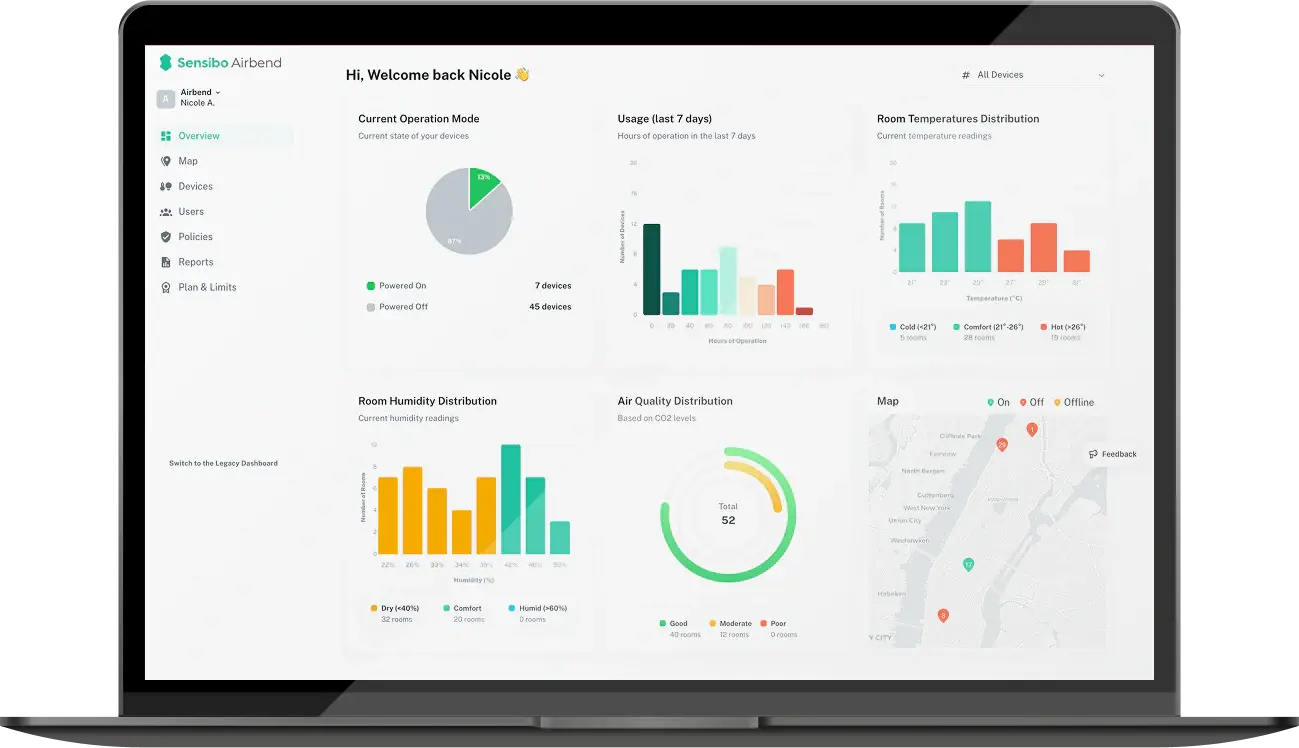Optimal Thermostat Setting for Fall: Challenges of Heating Home Efficiently in Autumn
Key Takeaways
- Overnight setbacks work wonders. Dropping the thermostat from 70 °F to 62 °F while you sleep can shave 25 – 35 % off weekly heating costs without sacrificing comfort.
- Soak up free solar gain. South‑ and west‑facing rooms often jump 10 – 20 °F on sunny afternoons, so pull back the heat 3 – 5 °F and let the sun do the heavy lifting.
- Follow nature’s rhythm. Warm the house just before sunrise, ease off by noon, and settle around 65 °F after dusk. Matching the outdoor cycle means fewer furnace sprints and steadier comfort.
- Upgrade to a smart thermostat with weather integration. Forecast‑driven tweaks, geofencing, and room sensors can add another 20 – 30 % in energy savings over basic scheduling.
- Mind humidity awareness. Fall air is dry; the same temperature feels cooler than in summer. Keep humidity balanced and you’ll stay cozy without dial‑turning inflation.
Fall arrives as a season of contradictions. Morning frost gives way to afternoon warmth that could pass for summer. Trees shed leaves while some days demand open windows. Your home exists within this atmospheric chaos, expanding and contracting with temperature swings that can span 30 degrees in twelve hours. Strategic thermostat setting for fall navigates these extremes, reducing energy costs by up to 25% compared to static temperature approaches. The challenge lies in reading autumn's signals rather than imposing artificial climate control.
October's Thermal Rebellion
Watch how fall temperatures behave across a single week. Monday begins at 38°F, climbs to 72°F, then crashes to 45°F by evening. Tuesday reverses this pattern with a 50°F dawn warming to only 60°F under gray skies. Wednesday delivers 75°F heat that feels misplaced in the season.
Your heating system, designed for winter's predictable cold, faces these schizophrenic conditions with mechanical bewilderment. Heat pumps cycle on for morning chill, shut down during afternoon heat waves, then restart as shadows lengthen. Gas furnaces fire up for brief bursts, overwhelm rooms with warmth, then idle for hours.
Building materials respond to these fluctuations like slow-motion thermometers. Concrete foundations absorb morning heat, releasing it hours after outdoor temperatures drop. Wooden floors expand in afternoon warmth, then contract through cool nights. This thermal lag creates a displacement between outdoor conditions and indoor needs.
The Architecture of Autumn Comfort
.png?width=800&height=400&name=image_2024-10-11_20-27-03%20(1).png) Solar Heat Distribution
Solar Heat Distribution
Fall reveals your home's thermal personality with unusual clarity. South-facing rooms bask in October sun that streams through bare tree branches, reaching deeper into spaces than summer's high-angle light. North rooms remain cool and shadowed, requiring consistent heating despite mild outdoor temperatures.
Windows become thermal battlegrounds during transitional weather:
- Single-pane glass conducts outdoor temperature changes directly into living spaces
- Double-pane windows moderate fluctuations but still transmit significant thermal energy
- West windows can raise room temperatures 15 degrees above thermostat setting levels during 2 PM sun exposure
- Same windows radiate heat loss during pre-dawn hours
Air Movement Patterns
Fall storms create pressure differentials that drive cold outdoor air through building gaps. Chimney effects intensify as temperature differences between indoor and outdoor air increase. Stack effect pulls cold air through foundation cracks while forcing warm air out through upper-floor openings.
Temperature Rhythms That Follow Nature's Clock
Autumn temperatures follow predictable daily cycles despite apparent randomness. Pre-dawn hours typically register the day's minimum temperature, regardless of whether that minimum reaches 25°F or 55°F. Solar heating begins within an hour of sunrise, gradually warming outdoor air through mid-afternoon.
Daily Temperature Progression
|
Time Period |
Outdoor Pattern |
Optimal Indoor Setting |
|
Pre-dawn (4-6 AM) |
Daily minimum temperature |
62°F |
|
Morning (6-10 AM) |
Gradual warming begins |
70°F |
|
Afternoon (12-4 PM) |
Peak temperatures + solar gain |
Reduce by 3-5°F |
|
Evening (6-10 PM) |
Steady cooling starts |
65°F |
|
Night (10 PM-4 AM) |
Continuous cooling |
62°F |
Your heating system can synchronize with these natural rhythms rather than fighting them. Morning warm-up cycles should begin 30 minutes before family wake times, gradually raising temperatures from overnight lows. Afternoon heating becomes counterproductive when solar gain raises indoor temperatures above comfort levels.
Smart Technology Reads Atmospheric Signals
.png?width=800&height=400&name=image_2024-10-11_20-26-25%20(1).png) Weather integration transforms thermostats from reactive devices into predictive systems. Tomorrow's forecast showing afternoon temperatures of 75°F triggers reduced morning heating to prevent overheating. Incoming cold fronts initiate early warm-up cycles to maintain comfort as temperatures plummet.
Weather integration transforms thermostats from reactive devices into predictive systems. Tomorrow's forecast showing afternoon temperatures of 75°F triggers reduced morning heating to prevent overheating. Incoming cold fronts initiate early warm-up cycles to maintain comfort as temperatures plummet.
Advanced Detection Features
Sensibo controllers bring atmospheric intelligence to existing HVAC systems through infrared control and Wi-Fi connectivity:
- Climate React automatically adjusts temperatures based on humidity and "feels like" conditions
- Geofencing capabilities warm homes as residents approach
- Room sensors provide localized temperature data revealing microclimates within buildings
- Weather integration modifies heating schedules based on outdoor forecasts
These systems excel during fall's unpredictable conditions by adapting to changing circumstances rather than following rigid programs. A warm October day might disable heating entirely, while an early cold snap triggers extended runtime to maintain comfort.
Energy Savings Through Thermostat Settings for Fall
Fall's moderate temperatures create ideal conditions for heating efficiency improvements. Smaller temperature differences between indoor and outdoor air reduce system workloads, allowing even modest adjustments to generate significant savings.
Proven Savings Breakdown
Overnight setbacks deliver the most substantial returns:
- 8-10 degree overnight reductions = 25-35% weekly heating bill reduction
- October nights cooling to 45°F require minimal heating at 62°F indoor settings
- Raising overnight settings to 70°F nearly doubles energy consumption
Daytime optimization provides steady efficiency gains:
- Reducing heating during sunny afternoon hours = 15-20% daily energy savings
- Evening setbacks using cooling outdoor air = additional 10-15% savings
- Solar heat utilization during peak sun hours = minimal heating requirements
Annual savings from proper fall thermostat management typically range from $150 to $400 for average homes, depending on size, insulation quality, and local energy costs.
Seasonal Progression Through Autumn's Three Acts
Early Autumn (September - early October)
Daily temperature ranges of 25-35 degrees challenge any fixed thermostat setting. Focus on preventing afternoon overheating rather than maintaining consistent warmth.
⮚Strategy: Minimal overnight heating, maximum solar gain utilization, aggressive evening cooling
Mid-Autumn (late October - November)
More predictable heating patterns emerge while maintaining enough variability to reward flexible approaches. Temperature targets increase gradually as average outdoor conditions cool.
⮚Strategy: Established overnight setbacks, consistent morning routines, winter preparation
Late Autumn (December approach)
Transitions toward winter heating patterns with reduced temperature swings and increased baseline heating requirements. Setback opportunities diminish as outdoor temperatures remain consistently cool.
⮚Strategy: System reliability focus, sustained winter operation preparation
Common Atmospheric Mistakes That Waste Money
.png?width=800&height=400&name=image_2024-10-11_20-25-23%20(1).png) Solar Radiation Neglect
Solar Radiation Neglect
October and November sun angles penetrate deeper into buildings than summer's overhead rays. South and west-facing rooms can gain 10-20 degrees from direct solar heating, yet many thermostats continue heating these spaces to programmed temperatures.
Fighting Natural Cooling
Fall evenings typically drop 15-25 degrees below afternoon peaks, creating free cooling opportunities. Homeowners who maintain constant indoor temperatures miss chances to use this natural cooling.
Humidity Misreading
Autumn air carries less moisture than summer conditions, making identical temperatures feel different. Dry 68°F air feels cooler than humid 68°F air, leading many people to increase thermostat settings in the Fall unnecessarily.
Reading Autumn's Energy Lessons
Fall teaches thermal lessons that apply throughout the heating season. Atmospheric patterns reveal your home's thermal strengths and weaknesses with unusual clarity. Solar gain opportunities, thermal mass behaviors, and air infiltration patterns become visible during transitional weather. Smart thermostat systems like Sensibo's retrofit controllers capture these atmospheric signals and translate them into automatic efficiency improvements. Master these natural rhythms, and your heating system will work with atmospheric forces rather than against them throughout the coming winter.
FAQ
What should the thermostat be set at in the Fall?
Fall settings should follow daily atmospheric patterns: 62°F overnight, 70°F during active morning hours, reduced settings during sunny afternoons, and 65°F evening temperatures. Adjust based on solar exposure, humidity levels, and occupancy patterns.
How much energy can proper fall thermostat management save?
Fall thermostat optimization typically reduces heating costs by 25-35% compared to static temperature settings. Overnight setbacks alone cut heating expenses by 40% during sleeping hours.
When should I switch from cooling to heating mode?
Switch to heating mode when nighttime temperatures consistently drop below 55°F or when daytime highs stay below 60°F for three consecutive days. This typically occurs in mid to late October.
How do smart thermostats improve fall efficiency?
Smart thermostats add weather forecasting, solar tracking, and humidity compensation that adapt to fall's changing atmospheric conditions. These features provide 20-30% additional energy savings through thermostat settings beyond basic programming.
Should fall settings differ from winter programming?
Yes. Fall requires dynamic programming responding to solar gain, thermal mass effects, and dramatic daily temperature swings. Winter settings can be more static since outdoor conditions remain consistently cold.
What's the most common fall thermostat mistake?
Fighting natural atmospheric cycles instead of working with them. Many homeowners maintain constant indoor temperatures despite 30-degree outdoor swings, missing free heating and cooling opportunities.


































.png)
.png?height=200&name=image_2024-10-11_19-44-45%20(1).png)

.jpg?height=200&name=image2%20(1).jpg)
-min.jpg?height=200&name=man-is-adjusting-temperature-using-tablet-with-smart-home-app-modern-living-room%20(1)-min.jpg)